Top News
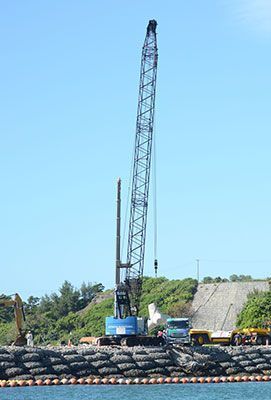
July 7, 2017 Ryukyu Shimpo
July 7 marked the fourth year since Okinawan citizens began sit-in protests in front of the U.S. military Camp Schwab. The sit-ins are to protests the new base construction, or the relocation of the U.S. military Futenma Air Station to Henoko, Nago City. Early morning on the same day, citizens gathered in front of the gate to once again reaffirm their vow not to let the base be constructed and raised their voices in protest.
The protest began in front of the gate around 8:30 a.m. Kazuo Sena, who is the Secretary General of the Anpo-Haiki & Okinawa-Ken Toitsuren, an organization that aims to abolish the Japan-U.S. Security Treaty, gave a powerful speech and said, “Today is the start of the fourth year in which we fight. Once again, we want to renew our efforts to never let the construction of the new base happen.” The citizens responded with a round of applause in approval.
Around 10:00 a.m., about 40 construction vehicles entered the base, causing temporary traffic on the road in front of the gate.
Meanwhile by the sea, Okinawa Defense Bureau trailers were seen carrying in wave dissipating blocks for the K9 seawall on the north side of the landfill area within Camp Schwab. The blocks were then lifted and lowered by cranes. On the south side of the K1 seawall, workers were seen taking measurements. Citizens who oppose the new base construction protested from two protest ships and 13 canoes.
(English translation by T&CT and Chelsea Ashimine)
Go to Japanese
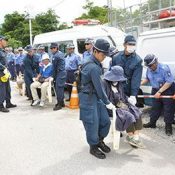
July 7, 2017 Ryukyu Shimpo
On the morning of July 7, ten citizens waged a sit-in at the front of the N1 Gate to the Northern Training Area (NTA) in Takae, Higashi Village to protest the construction of entry roads leading to helipads. Protestors stated that, “The fight Isn’t over yet.”
Sit-in protestors held up placards with messages such as: “Don’t destroy Takae” and “Don’t destroy the Yambaru woods.” An Okinawa Prefectural Police riot squad warned protestors not to sit in, and removed chairs with the protestors still sitting in them. The Okinawa Defense Bureau’s security personnel surrounded the gate, allowing about 15 heavy machines and trucks carrying sand and construction equipment to enter the base.
Twenty-eight-year-old Takae resident Ayumi Isa said that with Henoko also drawing attention people do not gather in Takae so much anymore, but the fight with construction is not over. She acknowledged that stopping construction may be difficult, but wants to watch closely to see what occurs in Takae.
The Okinawa branch of the Peace Forum’s Kazuo Morimoto, a 76-year-old who is originally from Kanagawa Prefecture and now resides in Naha, said that it is odd that despite the great sacrifices paid by Okinawa in the war, the bases are only being strengthened and not reduced. He said, “We must come together to prevent base construction.”
(English translation by T&CT and Erin Jones)
Go to Japanese

July 1, 2017 Ryukyu Shimpo
Spawning of Usuedamidoriishi or acropora tenuis, a species of coral, has been confirmed recently on reefs in Oura Bay, Henoko, Nago, where a new airfield is being built as part of the replacement of U.S. Marine Corps Air Station Futenma in Ginowan City.
Diving team “Rainbow”, of the Helicopter Base Objection Association, led by Osamu Makishi took pictures of the spawning scene. Members of the team called for the protection of the rich nature of Oura Bay at a press conference held on June 30 at a “struggle tent” near Henoko Beach.
The diving team took pictures of the coral spawning at Chiribishi west point on the night of June 28. Makishi said, “I want to tell the people how the sea creatures are trying hard to live, even while the construction is being forced.”
(English translation by T&CT)
Go to Japanese
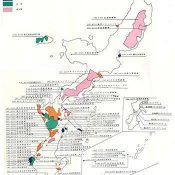
June 28, 2017 Ryukyu Shimpo
The Okinawa Prefectural Department of Environmental Affairs has prepared foundational materials titled “U.S. Base Environmental Records”, which contain information regarding the use history of and accidents involving environmental pollution at U.S. military facilities in Okinawa including b
ases that have already been returned, and posted these materials on the official prefectural homepage on June 26. It is the first time that the use history of land,
categorized by facility, has been collected in an effort to provide unified information in a database. The goal of this is to facilitate smooth land-use planning f
or U.S. military facility land that will be returned in the future.
Japanese and U.S. governments in 1972.
The records cover the 87 facilities set forth in the “Facility/Area Memorandum” (the 5/15 memo) exchanged between the
In Okinawa, there have been many cases in which contamination was discovered on land returned by the U.S. military after the land was returned, such as the case of barrels containing dioxins and other harmful substances being found buried in a soccer field in Okinawa City. However, measures to return the land to its original state have been inconsistent.
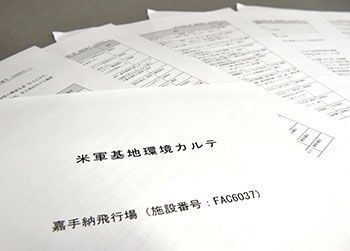
Information (partial) regarding Kadena Air Base compiled in the environmental records
Given this situation, in FY 2014, the prefectural government established a Special Management Office of Military Installation Envir
onmental Affairs, and over the course of three years until the end of FY 2016, the office compiled the aforementioned environmental records and “Okinawa U.S. Military Base Environmental Guidelines” to explicitly set forth the proper response by the prefectural government when environmental contamination deriving from U.S. military bases is discovered.
The records comprise a combination of information from interviews with Okinawans and documents from the U.S. Nat
ional Archives. In addition to basic information regarding each facility and a history of environment-related accidents at each facility, the records also contain matters to note when performing environmental surveys.
The records also contain groundwater foundation surface contour maps to facilitate prediction of water flow in the case where soil contaminants have flowed into groundwater. The information will be continuously updated, and there are plans to convert it into a GIS (Geographic I
nformation System) by the end of this fiscal year.
Fujimi Tamaki, head of the Special Management Office of Military Installation Environmental Affairs, encouraged the national government and related city, town and village governments to use the records, saying, “When land is returned or when environmental contamination comes to light, I hope the foundational information in the records is used as a basis to determine what kind of environmental survey should be performed with reference to the guidelines.”
The environmental records can be viewed on the official homepage of the Okinawa Prefectural Government (http://www.pref.okinawa.jp/site/kankyo/seisaku/karte.html).
(English translation by T&CT and Sandi Aritza)
Go to Japanese
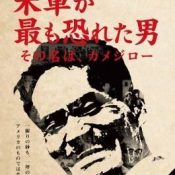
June 25, 2017 Ryukyu Shimpo
On August 12 at Sakurazaka Theatre in Naha City, documentary film “Kamejiro, the man the U.S. military was most afraid of” (directed by Takahiko Sako) will be preliminarily screened. The documentary is about politician Kamejiro Senaga who stood firm in protest against tyranny in Okinawa under US occupation.
The movie explores why citizens in Okinawa, where U.S. military bases remain concentrated even 45 years after reversion, continue to raise their voice, carrying on Senaga’s “unyielding” spirit.
Since becoming a news presenter on TBS’s “Tsukushi Tetsuya News 23,” 20 years ago, Sako has continued covering the base issues in Okinawa. He re-edited a documentary program broadcasted on TBS in August 2016, including new episodes revealed by further investigation, and made it into a movie.
After a preliminary screening in Okinawa, it will be screened in Tokyo on August 26.
(English translation by T&CT and Megumi Chibana)
Go to Japanese
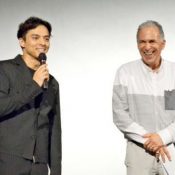
June 22, 2017 Ryukyu Shimpo
A movie depicting the spirit of non-combat, Star Sand, which was shot in Ie Island, was screened at the Sakurazaka Theater in Naha city on June 21. The movie told the story of American and Japanese deserters and a girl on an island of Okinawa during the war. The director Roger Pulvers and Okinawan actor Shinnosuke Mitsushima spoke to audience members at the screening. Director Pulvers said, “this movie opposes any form of violence including war and child abuse.”
Mitsushima, who plays a deserting Japanese soldier, shared why he decided to play the role, saying; “I myself have a grandfather who is American, and I would not have been born if the war didn’t occur. The message to love people in front of you, regardless of race, language and ideology, struck my heart.”
This is the first time for Mitsushima to play a role in a movie that uses Okinawa as a background. He said; “I have been thinking that I need to give back to my home. I feel that today is the new start of my life. I would like to suggest that the Sakurazaka Theater screen this movie every year on this day.”
(English translation by T&CT and Sayaka Sakuma)
Go to Japanese
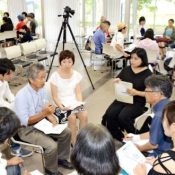
July 3, 2017 Ryukyu Shimpo
On July 2, in Naha City, the group Pokinawa (Positive Campaign Okinawa), which aims to overcome differences in opinion through dialogue, held a presentation to discuss plans to prevent crimes by U.S. military in light of the rape and murder of an Okinawan woman by a U.S. military civilian worker in April last year.
The group presented four plans, including the establishment of a permanent organization through which the Okinawa Prefectural Government and the U.S. military on Okinawa will consult regularly on crime prevention measures.
About 60 people, including citizens and experts, participated in the meeting and deepened understanding after exchanging opinions on the plans.
In addition to establishing a permanent organization, the plans include; (1) providing Okinawan culture education programs to U.S. military personnel and care programs to U.S. military veterans; (2) promoting mutual understanding through exchanges between citizens and U.S. military personnel; (3) removing U.S. military bases and transforming them into hubs to promote sports and culture.
Michiko Oshiro, a member of the group, which gave the presentation on the establishment of a permanent consultation organization, pointed out that the current consultative meeting consisting of the prefectural government, the central government and U.S. forces on Okinawa, had so far failed to prevent crimes. She added, “the prefectural government should be deeply involved in making and operating incident prevention measures, without leaving it entirely up to the central government and U.S. forces.”
According to the Pokinawa, the group will request that the prefectural government and the prefectural assembly set up the establishment of a permanent consultation organization.
(English translation by T&CT)
Go to Japanese
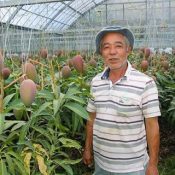
July 3, 2017 by Takahiro Arashiro Ryukyu Shimpo
Nakijin – A single mango tree has yielded close to 1,000 mangoes at Mineo Higa’s (65) mango farm, “Orchard Higa” in Imadomari, Nakijin, creating a buzz throughout the region. The tree is around 29 years old. The branches of the mango tree are held up on splints, allowing it to be spread out low to the ground in a formation with a diameter exceeding 10 meters. As the tree had grown too large, a number of surrounding mango trees had to be removed.
Normally, a single mango tree yields around 120 mangoes. The previous year, around 400 mangoes were harvested from Higa’s giant tree.
Last year, Higa noticed mites eating small insects outside, speculating that, “The mites were possibly eating thrips, an insect that is harmful to mangoes.” Higa gathered some of these Phytoseiidae mites and set them loose in the facility.
Thrips are harmful to the important parts of the mango including the sprouts, flowers, and fruits. They breed rapidly, and are resistant to pesticides. The insects are under 2 millimeters in size, making them difficult to detect.
Higa showed off the tree, smiling, “We lowered the amount of pesticides, producing safe, healthy mangoes. Our goal is agriculture that is in harmony with the surrounding environment. Since we grew many more mangoes than expected, I may apply for a Guinness World Record.” The mangoes are due to ship mid-July.
(English translation by T&CT)
Go to Japanese
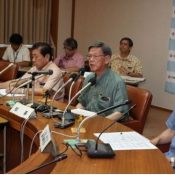
June 30, 2017 Ryukyu Shimpo
On July 7 the Trilateral Liaison Council concerning U.S. Kadena Air Base, which consists of Kadena Town, Okinawa City, and Chatan Town, will go to Tokyo. There, the council will submit its appeal to the Ministry of Foreign Affairs (MOFA) and the Ministry of Defense (MOD), requesting that parachute drop training at Kadena Air Base be discontinued and that use of the former U.S. Navy aircraft parking apron be prohibited. Four representatives of the Okinawa Prefectural government and other municipal government bodies will unite, proclaiming that they will not allow exceptions being made to the U.S.-Japan Joint Committee Agreement.
Up until now the prefectural government has taken the standpoint that parachute drop training should be carried out in accordance with the intent of the Special Action Committee on Okinawa (SACO) final report, and has not yet gone so far as to allude to prohibition of this training at Kadena Air Base. However, based on local feeling in the three aforementioned municipalities, which is due to training being forcibly conducted again and again, the prefectural government has come to request that the training be discontinued.
When the council submits its appeal to the MOFA and MOD on July 7, it will inquire about setting up interviews with both ministers. Since the US-Japan Security Consultative Committee (2+2) meeting is scheduled for the week after, the council will also address its appeal at the meeting and consult with U.S. representatives.
On the evening of June 29 at the Prefectural Office, Governor Takeshi Onaga, head of the Trilateral Liaison Council and mayor of Okinawa City Sachio Kuwae, mayor of Kadena Town Hiroshi Toyama, and mayor of Chatan Town Masaharu Noguni together disclosed their intentions in an interview. For the governor and three liaison council leaders to meet altogether prior to submitting an appeal is unusual. Governor Onaga said that the obvious inconsistencies between the application of the SACO agreement and its intent are intolerable.
Head of the Trilateral Liaison Council Kuwae claimed that the U.S. military has audaciously and easily tossed aside the idea of reducing the burden on local inhabitants. He said, “I recognize the importance of the U.S.-Japan Security Treaty, but on principle the degree of the base burden should have been further reduced by now.”
Mayor Toyama is greatly concerned that the training conducted in disregard of the SACO agreement will normalize this sort of activity in the future. Therefore, he considers this matter of utmost importance.
Mayor Noguni said that up to this point all the rules have been disregarded and furthermore freely leveraged. He thinks the Japanese government should review the contents of the SACO agreement once more, and uphold its rules.
(English translation by T&CT and Erin Jones)
Go to Japanese
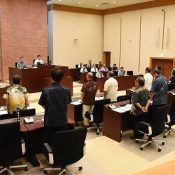
July 4, 2017 Ryukyu Shimpo online edition
On the morning of July 4, the Kadena Town Council held an extraordinary session at which they unanimously adopted a resolution and statement of protest concerning intensified noise pollution from foreign aircraft flying into Kadena Air Base. It was addressed during the session that due to many foreign aircraft, such as F-16 and F-35 fighter planes and U-2 reconnaissance planes, both deployed at the base and flying in from elsewhere, Kadena Air Base is congested to an abnormal degree. The Kadena Town Council requested: 1. adherence to the noise prevention agreement and implementation of noise abatement measures; 2. an immediate withdrawal of foreign aircraft (from Kadena Air Base); and 3. that from here on out all foreign aircraft be prohibited from flying into Kadena Air Base.
In May as well, when F-16 fighter planes from Buckley Air Force Base in Colorado came to be temporarily deployed to Kadena Air Base, the town council adopted a resolution and statement of protest to request planning toward noise abatement. The town council further protested and made appeals. Even after these efforts, F-35 fighter planes from U.S. Osan Air Base in South Korea and U-2 reconnaissance planes from U.S. Air Station Iwakuni came flying into Kadena Air Base.
Kadena Town Council members visited and appealed to the Okinawa Defense Bureau on July 4. On July 7, members will visit the Ministry of Foreign Affairs’ Okinawa Liaison Office, the Prefectural Office, and the Prefectural Assembly for the same purpose. After that, they will also deliver their resolution of protest to the U.S. Air Force’s 18th Wing.
(English translation by T&CT and Erin Jones)
Go to Japanese
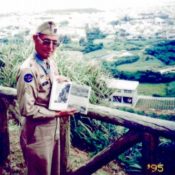
June 26, 2017 Ryukyu Shimpo
Katsutoshi Matsunaga
Desmond Doss (1919-2006) was the pacifist combat medic who refused to carry a weapon and saved 75 people in the Battle of Okinawa. More recently, his likeness was depicted as the protagonist in the movie Hacksaw Ridge, which premiered throughout Japan on June 24. Back in June of 1995, he met with Ryukyu Shimpo for an interview while visiting Okinawa. Doss, who was injured at Hacksaw Ridge (known as Maeda Kochi in Japan) in Urasoe during the fighting, was admitted to a U.S. army hospital five and a half years after the war for symptoms including persistent dreams of the battle, suffering from what we now know as Post-Traumatic Stress Disorder (PTSD). According to him, “The dreams had continued for some time, but I do not see them anymore. By talking about my experiences I was able to conquer them.”
Doss was 76 year-old at the time of the interview in 1995. The visit to Okinawa was his second post-war trip to the island, the first being in 1969. The visit in 1995 was to participate in the U.S. military’s 50th anniversary marking the end of the war, and he stayed from June 18-28.
In April of 1945, Doss landed on Okinawa with B Company, 1st Battalion, 307th Infantry, 77th Infantry Division. A Christian Seventh-day Adventist, he volunteered for the Army with the condition that he not carry a weapon, to uphold is strongly held belief in the 10th commandment “Thou shalt not kill.” He explained, “I did not go to war to kill, but rather to save people.” On May 5, 1945 Doss and B Company became entangled in unbelievably bloody battle while climbing Hacksaw Ridge.
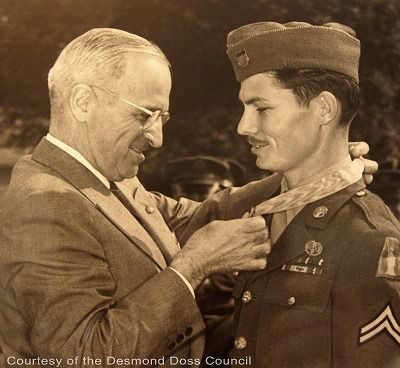
President Truman awarding Desmond Doss the Medal of Honor. October 12, 1945 Washington D.C. (Photo courtesy of the Desmond Doss Council)
The name of the movie, Hacksaw Ridge, comes from the jagged cliffs on Maeda Kochi in Urasoe. These same cliffs accompanied Desmond Doss, who the main character in the movie is modeled after, in the Battle of May 5.
The 150 soldiers attached to B Company scaled these cliffs to reach the top of the hill. “I prayed for my brothers at the top. I prayed for them to come back safely,” Doss reflected.
However, the Japanese Army lay in wait on the hill, and launched a violent attack led by mounted machine guns. This forced B Company to retreat. The soldiers began descending one-by-one down the cliffs, however the wounded soldiers were unable to move on their own and left behind.
Because of this, Doss stayed behind on the hill, and moved the wounded to the edge of the cliff, using a litter secured at the feet and chest to lower them down the cliff in an operation that took four hours.
The next day, the Japanese Army threw some grenades into the trench Doss was in, injuring his leg. Then, while being carried away on a stretcher five hours later, he was struck in the left arm by a Japanese bullet. He was taken to the military hospital in Guam, where he came down with tuberculosis, requiring the removal of one of his lungs.
Doss continued to see the nightmares which plagued him while he was in the hospital. Doss reflected “I could hardly sleep, and when I did in my dreams bombs would explode, killing me. I would see my friends dying. For whatever reason I saw my mother come to me on the battlefield, only to be killed by an explosion. I would awake in the middle, crying. Among my friends from the battle, I knew some whose nerves were completely shot. I do not see these dreams anymore. By talking about my experiences I was able to conquer them.”
While staying in Okinawa, he visited Maeda Kochi four times. He explained, “By coming here, I can confirm what happened then. I wanted to heal by coming to grips with what happened here.
22 years after the article, a note from the reporter who interviewed Desmond Doss
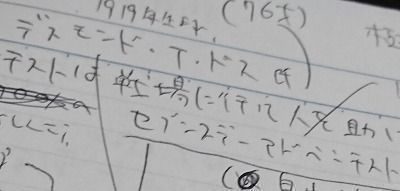
Interview notes from the Desmond Doss interview (from June, 1995)
At the beginning of this month, I saw the trailer for Hacksaw Ridge on the internet. The story told of a combat medic who saved many people in the war, while refusing to carry a weapon due to religious belief. I knew I had heard that story before. It was the story of the former serviceman I had interviewed when I worked at the Gushikawa bureau (now combined with the Chubu bureau).
I looked for the interview notes I had somewhere in my house. I found them, six pages of notes with the name “Desmond T. Doss” written in ball point pen at the top.
After the interview, I sent the article to the Society section, but it was not published. This was right before the memorial service for the 50th anniversary of the Battle of Okinawa, and there was already a surplus of articles about the battle. It seemed like my article had missed its chance. Now that the movie is being released, I decided to flip through my 22 year-old interview notes and revise the article.
(English Translation by T&CT and Sam Grieb)
Go to Japanese














 Webcam(Kokusai Street)
Webcam(Kokusai Street)


